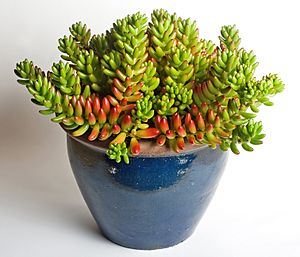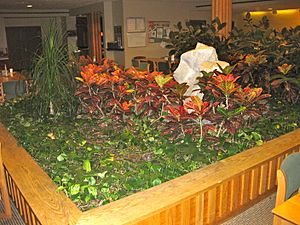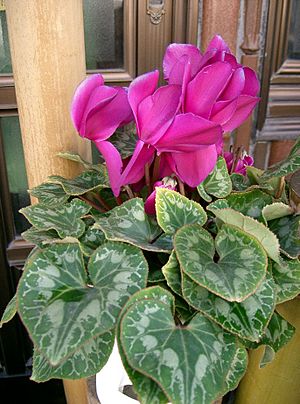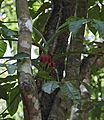Houseplant facts for kids

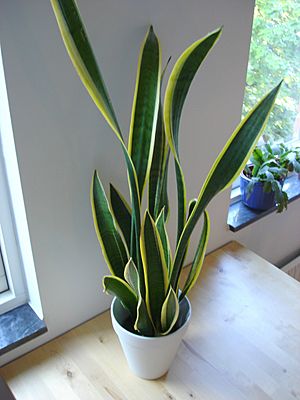
A houseplant is a plant you grow inside your home or office. People often grow them to make their spaces look nicer. Studies show that houseplants can also make you feel happier and help clean the air inside. Most houseplants are tropical plants, like epiphytes, succulents, or cacti. These plants usually come from warm places.
To keep houseplants healthy, they need the right amount of water, light, soil, temperature, and humidity. They also need the correct fertilizer and the right-sized pots.
Contents
Caring for Your Houseplants
Taking care of houseplants means thinking about water, light, soil mix, temperature, humidity, fertilizers, potting, and keeping pests away. Here are some general tips for houseplant care. You can find more specific details online or in books.
Watering Your Plants
Giving your plant too much or too little water can hurt it. The soil should feel moist, but not soaking wet. Imagine a damp sponge, not a puddle!
Light Needs
Different plants need different amounts of light. Some need lots of bright sun, while others prefer shadier spots. The amount of light a plant gets each day, called photoperiodism, is also important. For example, Poinsettias and Christmas cacti need shorter daylight hours to bloom.
If your home doesn't have enough natural light, you can use special plant lights. These lights give off the right kind of light for plants to grow.
Choosing the Right Soil
Houseplants usually grow in special soils called potting compost or potting soil. This isn't the same as the dirt outside! Good potting soil has things that give the plant nutrients, support it, let water drain well, and allow air to reach the roots.
Most potting soils contain peat and vermiculite or perlite. However, people are now using coir (which is coconut fiber) instead of peat. This is because peat comes from peat bogs, and harvesting it can harm the environment. Coir is a more sustainable choice.
Temperature for Houseplants
Most houseplants are tropical plants that stay green all year. They are used to warm weather, usually between 15°C and 25°C (60°F to 80°F). This is often similar to the temperature inside most homes, which makes them easy to care for.
Humidity Levels
Humidity is how much moisture is in the air. It's a bit harder to control than temperature. Most homes have about 20% to 60% humidity, which is fine for many houseplants. However, most plants really love humidity closer to 80%. You can increase humidity by misting your plants with distilled water or using a humidifier.
Plant Food (Fertilizers)
Plants need minerals from the soil to grow, just like we need vitamins. The main ones are nitrogen, phosphorus, and potassium.
- Nitrogen helps plants grow green leaves.
- Phosphorus is important for plants that flower or produce fruit.
- Potassium helps roots grow strong and helps the plant take in nutrients.
Plants also need small amounts of other elements like calcium, magnesium, and iron.
Pots and Their Sizes

Choosing the right pot size is very important. If a pot is too big, the soil might stay too wet and cause root problems. If it's too small, the plant won't be able to grow properly. Generally, a plant can stay in the same pot for about two years.
Pots come in different types:
- Porous pots are usually made of clay. They are great because air can pass through the sides, which helps the roots breathe.
- Non-porous pots are often plastic or glazed. They hold water longer and don't let as much air through.
All pots should have drainage holes at the bottom. These holes let extra water flow out, which stops the roots from rotting. If a pot doesn't have holes, you can put your plant in a smaller pot with holes inside the larger one. This way, you can lift out the inner pot and pour out any extra water. Always clean old pots with a bleach solution (1 part bleach to 10 parts water) to kill any germs.
How Houseplants Clean the Air
Houseplants can help make the air inside your home cleaner! They reduce things like volatile organic compounds (VOCs), which are chemicals found in many household products. Tiny living things in the soil around the plant do most of this cleaning. Plants also take in Carbon dioxide, which can make it harder to focus if there's too much of it indoors. NASA even studied plants for use in spacecraft to clean the air! Plants also seem to reduce tiny germs in the air and add moisture.
Different Ways to Grow Plants
Hydroponics
Instead of soil, some plants can grow in water with added nutrients. This method is called hydroponics. It has several benefits:
- It's usually odorless.
- The growing material can be reused.
- It's more hygienic.
- There are no soil-bound pests.
- The plant gets a steady supply of water.
However, not all plants grow well this way, and the special growing materials can be hard to find in some places.
Subirrigation
Subirrigation is another way to water plants, where water is given from the bottom of the pot. The water then moves up into the soil through a process called capillary action. This method has advantages:
- You can control the amount of water easily, reducing overwatering.
- You don't need to drain the plant after watering.
- It prevents the soil from becoming too packed down.
Popular Houseplants
Here are some well-known houseplants:
Images for kids
-
Still Life with Lemons, Oranges and a Rose, by Francisco de Zurbarán, 1633. Growing citrus trees indoors was popular back then.
-
A pot made by Josiah Wedgwood around 1780, used for making bulbs bloom indoors.
-
Different types of cactus growing in a desert.
See also
 In Spanish: Planta de interior para niños
In Spanish: Planta de interior para niños


